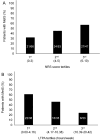Correlates of metabolic syndrome in people with chronic spinal cord injury
- PMID: 38285309
- PMCID: PMC11266227
- DOI: 10.1007/s40618-023-02298-8
Correlates of metabolic syndrome in people with chronic spinal cord injury
Abstract
Purpose: We aimed at identifying clinical risk factors or early markers of metabolic syndrome (MetS) in people with spinal cord injury (SCI) that would facilitate a timely diagnosis and implementation of preventive/therapeutic strategies.
Methods: One hundred sixty-eight individuals with chronic (> 1 year) SCI underwent clinical and biochemical evaluations. MetS was diagnosed according to modified criteria of the International Diabetes Federation validated in people with SCI. Wilcoxon rank-sum test and χ2 test were used to compare variables between groups with and without MetS. Multiple logistic regression analysis was performed to reveal independent associations with MetS among variables selected by univariate linear regression analyses.
Results: MetS was diagnosed in 56 of 132 men (42.4%) and 17 of 36 women (47.2%). At univariate regression analyses, putative predictors of MetS were an older age, a higher number of comorbidities, a lower insulin-sensitivity, the presence and intensity of pain, a shorter injury duration, a poorer leisure time physical activity (LTPA) and an incomplete motor injury. At the multiple logistic regression analysis, a significant independent association with MetS only persisted for a poorer LTPA in hours/week (OR: 0.880, 95% CI 0.770, 0.990) and more severe pain symptoms as assessed by the numeral rating scale (OR: 1.353, 95% CI 1.085, 1.793).
Conclusion: In people with chronic SCI, intense pain symptoms and poor LTPA may indicate a high likelihood of MetS, regardless of age, SCI duration, motor disability degree, insulin-sensitivity and comorbidities.
Keywords: Cardiovascular risk; Insulin resistance; Obesity; Pain; Paraplegia; Physical activity.
© 2024. The Author(s).
Conflict of interest statement
The authors declare they have no financial interests. Marco Giorgio Baroni and Arcangelo Barbonetti are members of the Editorial Board of the J Endocrinol Invest.
Figures

Similar articles
-
Metabolic syndrome is the key determinant of impaired vaginal lubrication in women with chronic spinal cord injury.J Endocrinol Invest. 2020 Jul;43(7):1001-1007. doi: 10.1007/s40618-020-01185-w. Epub 2020 Jan 25. J Endocrinol Invest. 2020. PMID: 31983040
-
Independent association of hypovitaminosis d with non-alcoholic fatty liver disease in people with chronic spinal cord injury: a cross-sectional study.J Endocrinol Invest. 2024 Jan;47(1):79-89. doi: 10.1007/s40618-023-02124-1. Epub 2023 Jun 5. J Endocrinol Invest. 2024. PMID: 37273143
-
Metabolic syndrome in people with a long-standing spinal cord injury: associations with physical activity and capacity.Appl Physiol Nutr Metab. 2016 Nov;41(11):1190-1196. doi: 10.1139/apnm-2016-0269. Epub 2016 Aug 15. Appl Physiol Nutr Metab. 2016. PMID: 27806636
-
Comparison of the prevalence of metabolic syndrome between individuals with spinal cord injury and the general population based on the cutoff values of abdominal obesity.Disabil Health J. 2025 Apr;18(2):101753. doi: 10.1016/j.dhjo.2024.101753. Epub 2024 Nov 17. Disabil Health J. 2025. PMID: 39645463
-
Waist circumference cutoff identifying risks of obesity, metabolic syndrome, and cardiovascular disease in men with spinal cord injury.PLoS One. 2020 Jul 29;15(7):e0236752. doi: 10.1371/journal.pone.0236752. eCollection 2020. PLoS One. 2020. PMID: 32726371 Free PMC article.
Cited by
-
In situ mass spectrometry imaging reveals metabolite alterations in gray and white matter after spinal cord injury.Exp Ther Med. 2025 Apr 11;29(6):117. doi: 10.3892/etm.2025.12867. eCollection 2025 Jun. Exp Ther Med. 2025. PMID: 40297619 Free PMC article.
-
Can We Borrow Your Intervention? Randomized Controlled Trial of an Older Adult Telehealth Wellness Promotion Program Adapted for Middle-Aged Adults With Physical Disability.Gerontologist. 2025 Jun 12;65(7):gnaf079. doi: 10.1093/geront/gnaf079. Gerontologist. 2025. PMID: 39969182 Clinical Trial.
References
-
- Barbonetti A, Castellini C, Francavilla S, Francavilla F, D’Andrea S (2022) Metabolic syndrome in spinal cord injury: impact on health. Acad Press. 10.1016/B978-0-12-822427-4.00031-910.1016/B978-0-12-822427-4.00031-9 - DOI
MeSH terms
LinkOut - more resources
Full Text Sources
Medical

